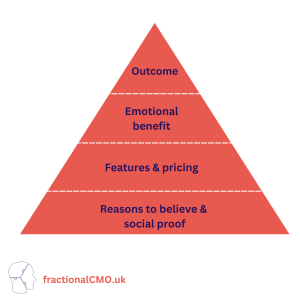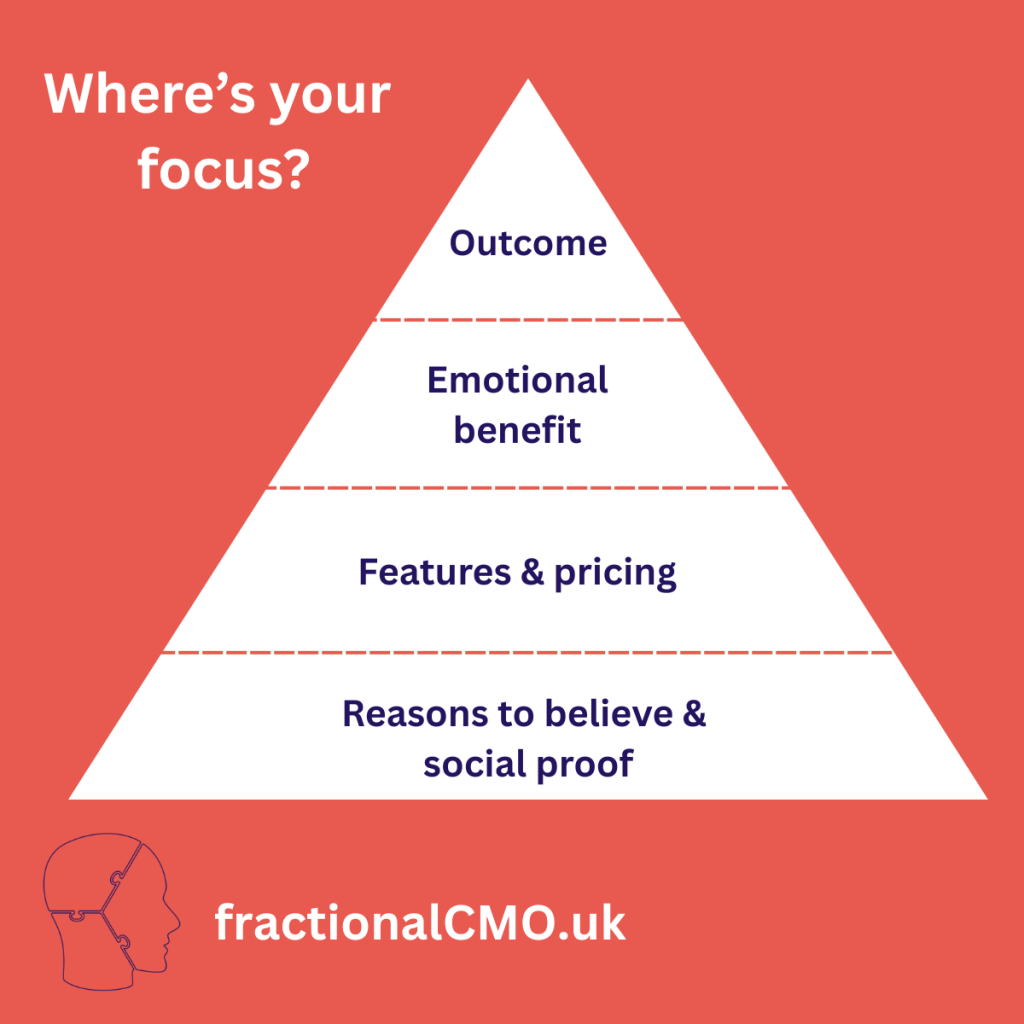We all know that we shouldn’t focus our marketing on features (or price), so why do we keep doing it? In part, it’s because we don’t focus on our marketing messaging hierarchy effectively.
Why features and pricing fail to differentiate
It’s too easy to focus on features. After all, your product team spent months developing them, (hopefully) based on thorough market research.
And when we believe we have ‘market-leading pricing’, we should shout about it, right?
Let’s look at features first. Cover your eyes, product managers:
Features are boring.
They really are the way to turn your prospects and customers off until they are almost ready to buy.
Part of the challenge is that – particularly early in the buying process – customers often fail to see the connection between a feature and their requirement.
Do you want a phone with a 108MP camera, or do you want a phone that takes great pictures in any light?
And as every good salesperson knows, benefits are better than features. And outcomes are better than benefits – more on that later.
What happens when your marketing focuses on pricing?
Price is important, of course it is. But what does it say about your brand, your product and your customers when you lead with it?
- You train customers to be loyal to price, rather than to your brand or your product
- It commoditises your product rather than differentiates it
- You attract the worst type of customers – more likely to churn, to be demanding and to complain
- It creates a race to the bottom
- It’s demotivating for your whole team – “Look! I work for the cheapest brand!”
Sometimes, of course, pricing is super-important. But try expressing that in terms of value rather than price, for example:
The hierarchy of marketing messaging

Like lots of marketing theory, it all sounds great and straight-forward.
But if you didn’t get the basics right in the first place, you won’t get the execution right either.
In this case, you need to have a really good understanding of your Ideal Customer Profile, along with their needs and emotional benefits, before you start to create your messaging hierarchy.
You also need a good grip of the outcomes your product or service provides. All the great storytelling in the world is for naught if you don’t show your prospect what they get from your product.
My hierarchy of marketing messaging goes as follows: Outcomes > Emotional benefits > Features & pricing > Reasons to believe & social proof
Let’s look at a specific example of a brand that does outcome-led marketing messaging brilliantly – and always has – Nike.
- Outcomes
Outcomes are what you really deliver. Nike sells trainers and sportswear. Nike really delivers victory, perseverance, self-improvement, and athletic identity.
The Metcon 10 is a ‘workout shoe’ – with a ‘lightweight ReactX foam’ inner and a ‘midfoot band’. But their message is “Strength Starts Here”. That’s the dream, that’s the outcome.
- [Emotional] benefits
Nike’s Metcon 10 “helps you conquer any movement your workout demands”. Conquer. That’s a strong word.
Benefits sell. And emotional benefits are benefits squared. - Features and pricing
We get to talk about the features down the page, deeper into the site, when the customer has shown more intent. But features still need to feed into the benefits and the customer need.
Back to the Metcon 10: “An ultra-strong Hyperlift plate under your heel (where you need it most) optimises stability for heavy lifts—like squats, dead lifts and cleans—without compromising the ride. “
And, frankly, if you don’t have £129.99 to spend on a pair of gym shoes, you probably haven’t got this far. - Reasons to believe and social proof
With Nike, we know the brand already and the social proof points are out there in every gym. But they still work it in down the page, giving customers the chance to rate the shoe and a link to upload images of them wearing the shoes on the site or mention on Instagram.
How to build your messaging hierarchy
Your messaging hierarchy only comes when you really understand:
- Your Ideal Customer Profile(s)
- Your value proposition
- Your brand values and mission
You can build your messaging hierarchy by asking yourself the following questions:
- What is the desired customer outcome?
- How do we want them to feel when they use our product?
- What have we got that can help us deliver that feeling and outcome?
- How have other customers felt when they used the product?
Final thoughts: moving from features to outcomes
Features are still important. Those three-column tables showing the features listed in your gold-silver-bronze pricing are pretty handy.
But starting with features is the path to disengagement.
The features are only there to deliver an outcome for the customer, and it’s outcomes that customers buy.

